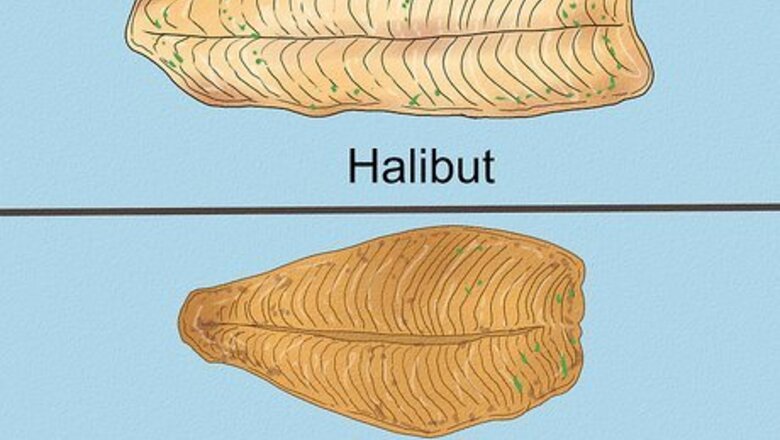
views
- Flounder and halibut taste similar, but flounder has a more delicate, flaky texture. Unlike flounder, halibut has a firmer texture that holds up on the grill.
- Overall, halibut is healthier and leaner than flounder. It’s packed with lean protein and omega-3s, ideal for weight loss.
- Frozen fish is usually cheaper than fresh fish, and it’s just as nutritious and flavorful.
- Halibut, flounder, and fluke are flatfish species. However, halibut is a type of flounder, while not all flounder and fluke are halibut.
Taste & Texture
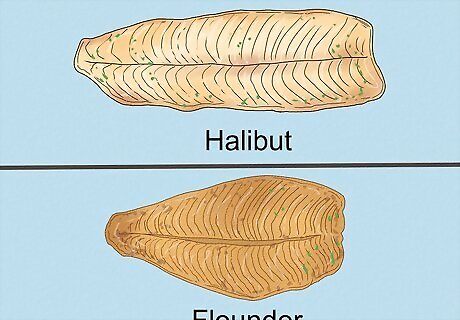
Halibut and flounder taste similar, but flounder is more delicate. Halibut has a dense, firm texture that’s ideal for baking, grilling, searing, and steaming. Flounder has thinner, fattier filets than halibut, so it doesn’t hold up on the grill. Instead, it’s best served poached, sautéd, or steamed. Halibut cheeks are meaty cuts near the lower eye, and seafood lovers claim they have a sweet, luxurious flavor, similar to scallops. Flounder has a mild, sweet taste, similar to branzino. It’s extremely versatile and forgiving, so you don’t have to be too worried when cooking it. Halibut becomes mushy when overcooked, so take it off the heat when it reaches an internal temperature of 145 degrees Fahrenheit (60 degrees Celsius).
Nutrition
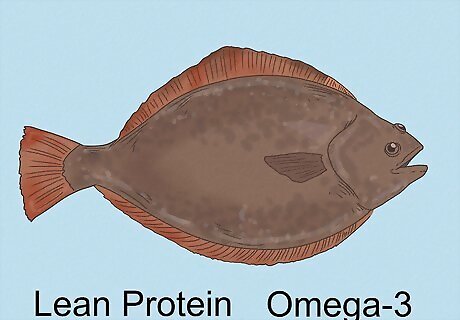
Halibut is leaner and healthier than flounder overall. Although flounder has lower mercury levels than halibut, halibut is packed with lean protein and brain-boosting omega-3s. Halibut is also more filling than flounder, making it a perfect weight-loss meal. Per 3 oz (85 g) serving: Atlantic and Pacific halibut contains: 186 calories 2.7 g fat (0.6 g saturated fat) 139 mg sodium 0 g carbs, 0 g fiber, 0 g sugar 37.9 g protein 396 mg Omega-3s 261 parts per billion of Mercury Flounder contains: 60 calories 1.6 g fat (0.4 g saturated fat) 252 mg sodium 0 g carbs, 0 g fiber, 0 g sugar 10.6 g protein 208 mg Omega-3s 115 parts per billion of Mercury
Cost
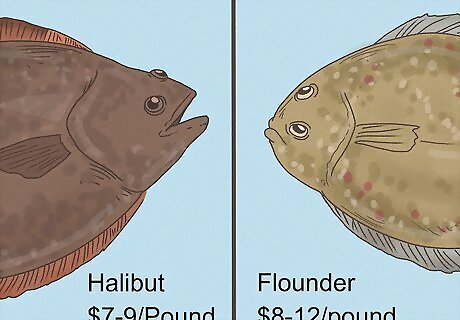
Halibut is slightly cheaper per pound than flounder. Although fish prices fluctuate with supply, the average retail price for flounder filets ranges from $8-12 per pound ($17.64-26.46 per kg). Halibut, however, can be found between $7-9 per pound ($15.43-19.84 per kg). If you can’t find fresh halibut or flounder, purchase frozen filets instead. Frozen fish is often cheaper than fresh fish, and there’s no difference in taste or nutritional value between the two. Fresh filets often remain in your grocery store for over a week, while the fish you find in the freezer aisle is frozen right after it’s caught.
Size
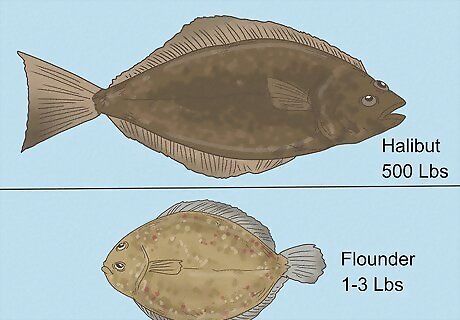
Halibut are longer and larger than flounder. Halibut are the largest flatfish, weighing up to 500 lbs (227 kg). Males rarely reach a length of 3 feet (0.9 m), but females can grow over 8 feet (2.4 m). Flounder, on the other hand, ranges from 1 lb (0.5 kg) to 3 lbs (1.4 kg), with the largest varieties weighing up to 17 lbs (7.7 kg). Male flounder grow up to 2 feet (0.6 m) in length, while females grow up to 3 feet (0.9 m). Fishermen frequently refer to halibut as “barn doors” because they’re so heavy.
Appearance
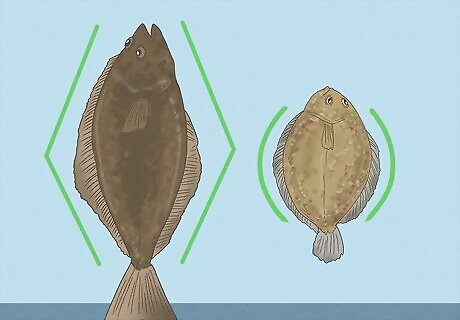
Halibut have pointed bodies, while flounder have a rounder shape. Unlike other flatfish, halibut have forked, crescent-shaped tails, and a wide, diamond-shaped body. They have small scales buried in the skin, giving them a smooth, glossy texture. Since flounder are shorter in length than halibut, they appear more round and oval-like. Their skin is also quite thick, so it’s usually skinned before cooking.
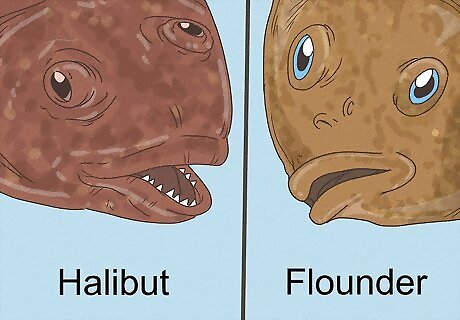
Halibut are right-eyed, while most flounder are left-eyed. All flatfish have both eyes on one side of their head, allowing them to see when they’re buried on the seafloor. However, left-eyed halibut are extremely rare: only 1 in 20,000 halibut have eyes on the left side of their head. Halibut and flounder are born like normal fish, but they flatten a few days after hatching. During this process, their eyes shift to one side, where they remain close together for the rest of their lives.
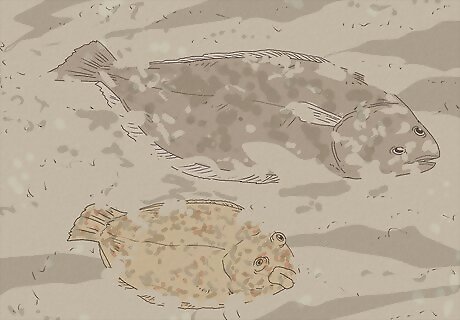
Both halibut and flounder can change color to match their habitat. Halibut and flounder are typically mottled gray, olive, brown, or black, but they have pigment-packed chromatophore cells that allow them to change color instantly. When they swim near the surface to feed, their skin becomes almost translucent in color, helping them avoid predators below, but they become more spotted and textured as they return to the ocean floor. The underbelly or “blind side” of both species is a white or dusky color, much lighter than the eyed side.
Habitat
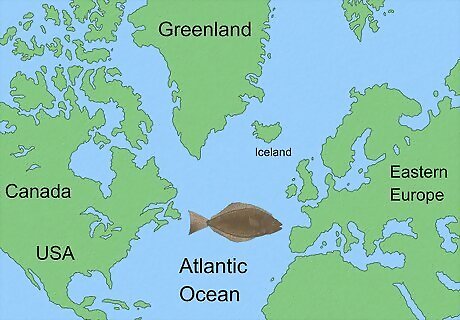
Halibut live farther north than flounder. Both halibut and flounder are saltwater dwellers that live on the ocean floor, but halibut prefer deeper waters. Pacific halibut live in depths between 20 ft (6.1 m) to 1000 ft (304.8 m), with temperatures ranging from 37 degrees Fahrenheit (2.8 degrees Celsius) to 46 degrees Fahrenheit (7.8 degrees Celsius). They’re often caught near the continental shelf through the northern Pacific Ocean, but other halibut species are found off the coast of Canada, Russia, and Japan. Atlantic halibut live all over the North Atlantic, including Massachusetts, Greenland, Iceland, and Eastern Europe.
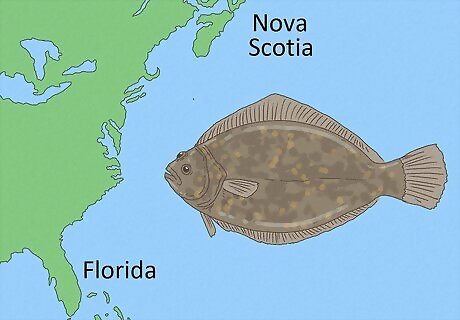
Flounder live in cooler, more widespread waters than halibut. Unlike halibut, flounder swim in a variety of waters across the globe. Summer flounder (also known as fluke) live in coastal waters, from eastern Florida to Nova Scotia, but they’re mainly found in the mid-Atlantic region near Cape Cod and the Carolinas. Flounder live in a wide range of waters from shallow estuaries to depths of over 500 ft (150 m). They prefer living in temperatures between 32 degrees Fahrenheit (0 degrees Celsius) to 50 degrees Fahrenheit (10 degrees Celsius), but winter flounder can survive icy conditions of 28.4 degrees Fahrenheit (-2 degrees Celsius)–the freezing point of seawater.
Classification
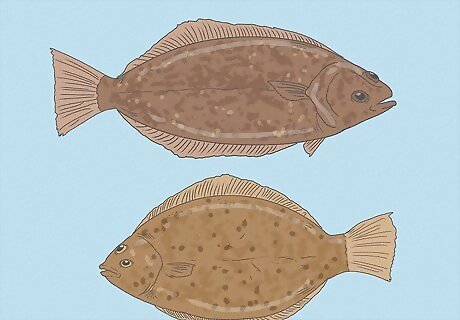
A halibut is a type of flounder, but not all flounders are halibut. Flounder is a general term for flatfish, including flounder, halibut, plaice, sole, and turbo. All species in the flatfish family (Family Pleuronectidae) are flattened laterally and swim sideways, with asymmetrical eyes on the same side of the head. Summer flounder is also known as fluke, and they’re the most important commercial flatfish on the east coast. Male and female halibut live up to 55 years old, but flounder have much shorter lifespans. Female southern flounders live up to 7 years old, while males rarely live past 3 years old. Inexperienced fishers often confuse the Pacific halibut with the arrowtooth flounder. While the Pacific halibut has small, smooth scales, the arrowtooth flounder has coarse scales and sharper teeth.




















Comments
0 comment